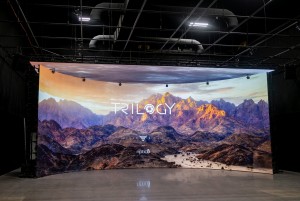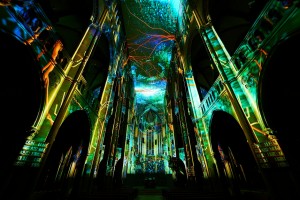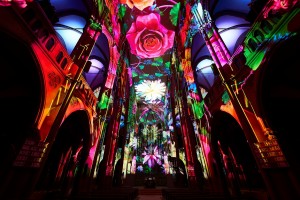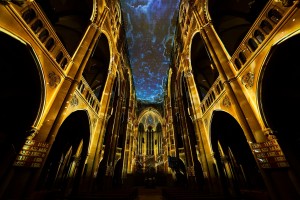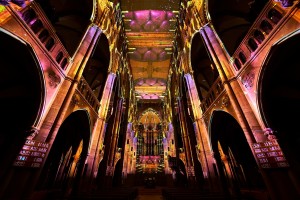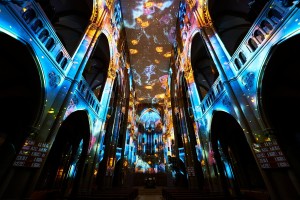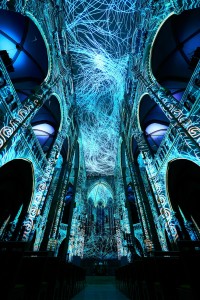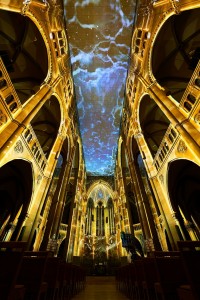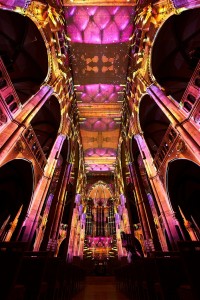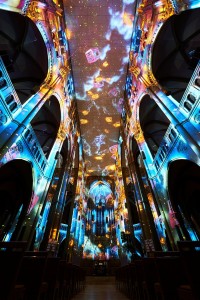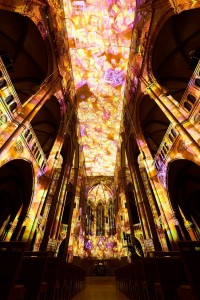AV-Medientechnik News
AV-Medientechnik News Schlagzeilen
Manganelli stattet Auditorien in Rennes mit Projektionstechnologie von Digital Projection aus
23/06/2025
Videlio and APG’s immersive audio boosts retail experience at Europe’s largest shopping mall
04/03/2025
Christie CP4420-Xe Xenon Projector chosen to launch Scotland’s first DCI-compliant grading studio
26/02/2025
HFF nimmt Deutschlands erste Crystal LED Verona von Sony für Virtual Production in Betrieb
03/12/2024
Christie ProAV solutions power new digital ocean experience at Xpark Aquarium
Christie’s projection and media playback solutions are powering the new “Xpark meets Naked - Ocean of Light: Immersive Ocean” exhibition at Xpark Aquarium in Taipei. Created by Japan’s creative company Naked, Inc., the exhibition officially opened to the public on June 28, 2025, as part of the aquarium’s fifth anniversary celebrations.
The new attraction fuses real marine life with digital art from the “Naked Ocean” series to create an immersive, multi-sensory journey. Combining oceanic projections, interactive displays, and visual storytelling, the exhibition reimagines the ocean as a living canvas - where nature, creativity, and technology come together to inspire awe and reflection.
Christie’s longstanding partner Dacoms Technology was responsible for the projection design and systems integration for this large-scale attraction. The setup features fifteen Christie 1DLP laser projectors, including Inspire Series DWU960ST-iS fitted with short throw zoom lenses, GS Series DWU880-GS projectors, and six Pandoras Box Servers for real-time video playback and content processing.
The projectors are used to project lifelike visuals across expansive curved walls and floors, immersing visitors in dynamic marine environments that pulse with light, sound, and motion. With this latest installation, Christie adds to a growing legacy at Xpark, which previously deployed over sixty Christie projectors - including GS Series and Captiva Series models - and twenty Pandoras Box Servers, Compact Players, and Widget Designer when the aquarium first opened.
“We’re thrilled to see our technologies once again at the heart of such a forward-thinking exhibition”, says Jason Yeo, Senior Sales Manager, Southeast Asia and Taiwan, Christie. “The collaboration between Xpark and Naked, Inc. pushes the boundaries of digital storytelling and environmental awareness.”
“Ocean of Light: Immersive Ocean” is the first major collaboration between Xpark and Naked, Inc., following the success of their initial partnership in January 2025 with the limited-time attraction “Xpark - Sea of Light Jellyfish - by Naked, Inc.”. This second phase marks a significant expansion, with nearly seventy percent of the indoor zones renewed with digital installations.
“Designed as immersive edutainment, this exhibition is more than just a visual feast”, says Terence Lee, Executive Vice President, Dacoms Technology. “It invites guests of all ages to explore the ocean’s diversity, ecosystems, and conservation challenges through all five senses.”
(Photos: Dacoms Technology)
Transparent Infiled screen takes pole position at Circuit Paul Ricard
Guests arriving at the Circuit Paul Ricard in Le Castellet, France, are now greeted by an architectural centrepiece: a transparent LED display stretching fifteen metres across the facade of the venue’s main entrance. A fully bespoke solution designed and customised by Infiled and installed in close collaboration with French integrator ND Tech Med, the large-scale installation is among the biggest transparent LED screens in Europe.
Broadcasting live race coverage, interviews and sponsor messaging, the display is a custom solution tailored specifically by Infiled to the demanding technical, aesthetic and structural requirements of the historic racetrack (long-time home of Le Mans and Formula 1 racing, as well as numerous other motorsports, cycling and running events).
For the project, Infiled designed a total of 96 transparent LED panels, with four panel sizes fitted precisely across each of the circuit’s 32 glass canopy windows to within millimetre tolerances. The complete screen measures 15 m wide by 5.4 m high, delivering a surface area of 81 square metres.
To maximise visibility and clarity for a moving crowd, the display employs a horizontal pixel pitch of 4 mm and vertical pixel pitch of 8 mm. One of the key design challenges was finding the right balance between light transmission and screen intensity: too transparent and the image would be washed out; too opaque and the installation would lose its architectural impact.
Equally complex were the structural challenges, as a screen of this size presents a significant load. Infiled and ND Tech Med engineered a custom fixing system to ensure long-term stability while accommodating thermal expansion, preventing any risk of stress or damage to the glass canopy below. The mounting solution also ensures rapid maintenance access.
The design and development process for the install included a fact-finding visit to Infiled’s Barcelona showroom, followed by three on-site demos at the Circuit Paul Ricard itself to test and refine the bespoke concept under real-world conditions.
(Photos: Morgan Mathurin)
Manganelli stattet Auditorien in Rennes mit Projektionstechnologie von Digital Projection aus
Um künftig immersive visuelle Erfahrungen bieten zu können, wurden kürzlich zwei Kultur- und Konferenzzentren im französischen Rennes mit Projektionstechnologie von Digital Projection aufgerüstet. Die Doppelinstallationen im Couvent des Jacobins und Les Champs Libres wurden von dem in Lille ansässigen Systemintegrator Manganelli angeführt.
Les Champs Libres ist ein multidisziplinärer Veranstaltungsort, der zusätzlich zu seinen Konferenzeinrichtungen auch eine Bibliothek, ein Museum und ein Naturwissenschaftszentrum beherbergt. Um eine Vielzahl von Veranstaltungen zu unterstützen, integrierte Manganelli ein Titan-Satellitensystem (MLS) von Digital Projection mit 20.000 Lumen und 4K-Auflösung.
„Ziel war, den Videoprojektor nicht im Kontrollraum zu haben, sondern ihn im Auditorium zu platzieren“, erklärt Stéphane Bourdon, Regional Sales Manager für Südwesteuropa bei Digital Projection. „Um die Zuschauer im Auditorium nicht zu stören, entschieden wir uns für die Satellitenversion, die uns erlaubte, nur den Kopf - der keine Geräusche macht - im Auditorium zu platzieren und die RGB-Laserquelle im Technikraum.“
„Wir haben eine Reihe von Tests mit anderen Marken durchgeführt, und die Satellitentechnologie war die einzige, die unseren Ansprüchen an einen leistungsstarken Projektor ohne die üblichen Unannehmlichkeiten wie Lärm, Hitze oder ein großer Schrank gerecht werden konnte“, ergänzt Dewi Seignard, FOH-Manager bei Les Champs Libres. „4K-Kompatibilität war ein weiterer entscheidender Faktor, ebenso wie die Farbwiedergabe. Wir danken Stéphane Bourdon und seinem Team für ihre Verfügbarkeit und Unterstützung während und nach der Integrationsphase.“
Nur einen Katzensprung vom Les Champs Libres entfernt befindet sich das Couvent des Jacobins, ein Wahrzeichen von Rennes architektonischem Erbe. Es wurde 2018 in ein Kongresszentrum umgewandelt, nachdem es einer großflächigen Modernisierung unterzogen worden war. In seinem Auditorium mit 1.000 Sitzen installierte Manganelli einen Titan-33000-4K-UHD-Projektor mit bis zu 31.000 Lumen bei 4K-Auflösung.
Couvent des Jacobins, ein ISO-20121-Unternehmen, hatte Manganelli nach einer öffentlichen Ausschreibung im letzten Jahr unter anderem deshalb gewählt, weil der Integrator alle Anforderungen bezüglich des Nachhaltigkeitsengagements erfüllen konnte.
Brompton Hydra calibration breathes new life into Rentex’s LED panel inventory
Brompton Technology has deployed its Hydra advanced measurement system through its partner Red Rock OPS to revitalise Rentex’s LED panel inventory. Red Rock OPS, a Las Vegas-based consulting firm which specialises in live overlays, colour calibration, and broadcast services, used Brompton’s calibration technology to enhance the performance of the nationwide AV rental provider’s existing LED panels and extend their lifespan.
“Rentex came to us because their current product was coming to the end of its lifespan”, says Angel Banchs, Owner and Lead Colour Engineer at Red Rock OPS. “We went to their Las Vegas facility and started calibrating panels.” The calibration process has given Rentex’s ROE BP2 and BP2V2 panels a new lease of life. The company supplies events of all sizes and scales, with customers including Encore, Freemans, PRG, and more.
“Rentex is a great use case because they rent to so many industries”, notes Banchs. “You might get some panels used for XR, you might get some for general convention, and general sessions nowadays are really focused on panel colour and performance, so that’s really important.” Sergio Sandoval, Senior Product Manager for LED & Projection at Rentex AV Rentals, adds: “Extending the ROI of a product that’s already five or six years old for another five years makes a huge impact for us.”
“Although it’s a five-year-old product, and these tiles had been discontinued when Hydra was created, Hydra extends their life and adds so many more features that weren’t available when the panel was first purchased”, explains Banchs. “Now they have Extended Bit Depth on black, HDR capability, and a bunch of other features that Brompton has made available.”
The Hydra system’s portability brings both economic and environmental benefits. “In terms of sustainability the system is compact, but powerful, so I can fly the rig to their offices, which saves everyone revenue by not having to fly the tiles across the country”, says Banchs. Sandoval adds: “On top of that, sometimes tiles are needed in a location by a certain deadline, so calibrating them locally is the best solution for us.”
Following the successful initial calibration, Rentex is working to consolidate its panels from twelve locations to facilitate comprehensive calibration of its entire inventory.
Pictured (left to right): Sergio Sandoval, Senior Product Manager for LED & Projection at Rentex AV Rentals; Webster Moyle, Technical Sales Manager at Brompton Technology; Angel Banchs, Owner and Lead Colour Engineer at Red Rock OPS. (Photo: Brompton Technology/Red Rock OPS/Rentex)
KPS Studios takes live sports productions remote with AJA Bridge Live
IP (internet protocol) and remote production are transforming how live sports coverage reaches fans worldwide. Recognizing the potential of both, broadcast production and equipment rental company Kaleidoscope Production and Services LLP (KPS Studios) helped facilitate the first remote production of the Durand Cup, one of India’s biggest annual football tournaments, last summer.
Since then, it’s continued to refine its multi-camera IP and remote production pipeline to deliver the fast-paced action of several other live sports events to fans across the Asia Pacific region. To ensure low-latency viewer experiences in multiple languages across a range of destinations and device types, the company built AJA Video Systems’ IP video solution Bridge Live and 16-channel OpenGear audio embedder/disembedder OG-12G-AMA into its workflow.
Production of the Durand Cup, one of Asia’s most storied football events, assembled a team of more than 150 crew, including producers, directors, camera operators, sound engineers, and broadcast engineers, spread across six tournament venues throughout India. Leveraging multiple cameras in each venue, KPS transmitted HD feeds to a master control room in Kolkata, where its team processed the footage, and added in slow-motion replays, graphics, and commentary. Then, it distributed the feeds to Sony TV via traditional broadcast, streaming apps Sony LIV and SSEN for over-the-top (OTT) delivery, and social platforms. By using Bridge Live, the KPS team was able to move between SRT (secure reliable transport) and H.265 and support low-latency streaming demands.
Given the team had to produce the feed for distribution in multiple languages, they also used AJA’s 16-channel OG-12G-AMA OpenGear analog audio embedder/disembedder card. “We can embed eight channels of audio with OG-12G-AMA, which is increasingly important as we’re tasked with embedding more languages into an SDI feed”, says KPS Studios Technical and Managing Director Rajiv Mehra, who tapped AJA distributor ARK InfoSolutions to ensure seamless integration of Bridge Live and OG-12G-AMA into KPS Studios’ workflow.
“Remote production is clearly the future and can provide tremendous cost savings, while also reducing a production’s carbon footprint", he adds. "And 4K workflow adoption is on the rise, which means SMPTE ST 2110 IP video will soon become necessary. While we’re transmitting today in HD, we understand we’ll need to move to 4K, and coaxial cable can’t provide the bandwidth like an IP network can. We’re actively exploring how we can build SMPTE 2110 into our pipeline this year.”
(Photo: AJA Video Systems/KPS Studios)
Infiled develops LED cube for Genève-Servette Hockey Club
Infiled has partnered with Swiss AV integration specialist Lemanvisio to design and deliver a custom-engineered, four-sided LED video cube for the championship-winning Genève-Servette Hockey Club (GSHC).
Designed to enhance the match-day experience by providing the club’s supporters with a visual experience from every angle, the new 96 m² display brings immersive, high-resolution visuals to Patinoire des Vernets, the Geneva home of GSCH, one of Switzerland’s most celebrated ice hockey teams.
Following GSHC’s recent historic double win as both Swiss and European champions, the team sought to invest in a new LED centrepiece display to augment the on-court action and create a more immersive and sponsor-friendly environment at its home arena. Working closely with Lemanvisio, its official AV partner, GSHC commissioned a dynamic video cube that would offer uninterrupted visuals and withstand the technical demands of an indoor ice hockey venue.
To meet this brief, Infiled supplied a customised version of its MV Series of LED displays already deployed at several sports venues and events, including the Etihad Stadium in Australia and the UEFA European Championships in France.
The installation posed several challenges, including environmental factors such as humidity and temperature gradients inside the arena and the structural demands of suspending a centre-hung display above the ice. To address these challenges, Infiled developed a bespoke solution featuring curved 90° cabinet corners to eliminate visual interruptions.
The display’s lightweight magnesium-aluminium frame reduces structural load on the roof, while its robust mounting system was adapted to ensure safety well beyond standard requirements. Further innovations included vibration resistance and dual data and power redundancy, safeguarding against signal or power loss during live gameplay, and gold-wire LED technology to protect against oxidation caused by high humidity levels from the ice.
Infiled worked in close partnership with Lemanvisio throughout the design, customisation and installation process.
(Photos: Infiled)
Vlast live streams virtual K-pop concerts with AJA gear
Virtual idols are poised to revolutionize entertainment, with the market projected to top $4 billion by 2029. Crafted with motion capture and game engine technology, these characters sing, dance, and interact with audiences online. Vlast, the South Korean entertainment agency and visual effects (VFX) technology company behind the virtual K-pop phenomenon Plave, is bringing the trend to live event productions.
Vlast has delivered two live Plave concerts, the most recent using NDI sources, streamed via the SRT protocol, and produced leveraging a suite of AJA equipment. With the NDI protocol enabling the transmission of video and audio sources over IP, Vlast has reduced cabling and simplified the process of sharing sources among operators. “Our NDI system has given us a robust and simplified means of distributing primary sources”, says Vlast CTO Lee Hyun-Woo.
Leveraging devices with NDI outputs, Vlast can now transmit PC signals in real time between various equipment without complex connections. “Regardless of the output method of each device we use, we can transmit and utilize signals from various devices with a single LAN cable, enhancing efficiency while improving the speed of transmission”, explains Hyun-Woo.
Vlast first implemented its IP workflow for Plave’s “Hello, Asterum!” Encore concerts, held last October at Seoul’s Chamsil Indoor Stadium. Leveraging an AJA Bridge Live IP video workflow solution, Vlast transmitted two 4K 30p sources to an on-site LED screen using public broadband networks secured with SRT to deliver the live stream. SRT enabled real-time transmission of high-quality video with low latency, allowing Vlast to maintain the same image quality for displays at the concert venue while cutting costs compared to traditional fiber transmission.
“We needed to distribute both the main and PGM sources to the on-site LED screen to three different points”, notes Hyun-Woo. “We monitored the final output screen in the production studio and input the two sources into the primary and backup AJA Bridge Live for SRT transmission. Our aim was to minimize image degradation to ensure that full 4K picture quality was delivered.”
While all primary sources for the concert leveraged NDI, the final output equipment was configured based on 12G-SDI. The main and HDMI PGM sources from the production PC were input into AJA HA5-12G and Hi5-12G Mini-Converters to support conversion between 12G-SDI and HDMI 2.0. AJA 12G-AMA Mini-Converters facilitated analog audio embedding/disembedding. With these solutions in place, Vlast was able to minimize signal chain issues.
Vlast then connected the HDMI output to a PC monitor, and the SDI output was input to an AJA Kumo 1616-12G SDI router for seamless distribution. The Vlast team configured the router to distribute the main and PGM sources as 1x3, and the output of the router was input to the main/PGM broadcast monitor and a primary/backup AJA Bridge Live for SRT transmission. Bridge Live simultaneously encoded two channels of 4K 30p sources in SRT, and a second unit performed SRT decoding at the concert site to transmit the main and PGM sources to the LED screen.
Vlast is primarily using its NDI and SRT workflow to live stream a variety of content and events on YouTube. Beyond that, the virtual idol pioneers plan to use SRT transmission to take their virtual K-pop stars to an even wider audience with an expanded range of content. “By approaching technology and business with fresh eyes and new ideas, we can continue to differentiate ourselves through innovative content experiences and expand our presence in global entertainment”, concludes Hyun-Woo.
(Photos: AJA Video Systems/Vlast)
Cromorama simplifies color management and quality control for live productions with Orion-Convert and AJA ColorBox
Well-executed productions come off seamlessly to audiences, regardless of the delivery format, but their underpinning is complex. Today, crews often work with a host of high dynamic range (HDR) and standard dynamic range (SDR) cameras and equipment, each with its own color science. Achieving a consistent look often requires crews to be able to color match production cameras and convert between SDR and HDR standards.
However, broadcasters can still encounter quality control (QC) issues, where the feed they output looks “off” and adjustments must be made. European HDR and color management consultancy firm and software developer Cromorama is streamlining this process with its Orion-Convert color pipeline, which is built into AJA’s ColorBox and OG-ColorBox color management and conversion solutions. Cromorama’s aim is to make color management more accessible for clients while also supporting QC demands.
“We’re a company that’s all about improving color iteration, and the Orion-Convert algorithm originated out of a need we saw amongst clients”, says Cromorama CEO and CTO Pablo Garcia. “Before Cromorama, there wasn’t an easy way to execute high quality conversions between HDR and SDR with the level of control we wanted. This gap in the toolset was especially noticeable when we were preparing for a major 2020 international sporting event on behalf of a client, so we envisioned a piece of code and started fine tuning it.”
That effort, says Garcia, led to the development of Orion-Convert, an intuitive engine with a two-stage compression process for full color management from display to display, SDR to/from HLG and PQ. The Cromorama team regularly deploys the software to serve clients globally, as it provides film production, broadcast, and research and development (R&D) services; it’s also a core technology behind NBCU LUTs.
“The color management learning curve used to be steep, especially in broadcast, but we’ve reached an inflection point”, continues Garcia. “Orion-Convert in AJA ColorBox and OG-ColorBox, a platform that’s well targeted to live production demands, provides more control over SDR and HDR transforms, so it’s easier to adapt to various scenarios in the field. Both hardware solutions are also valuable for QC purposes because I know I can trust them. If a broadcaster encounters an issue with their feed, I can run it through a ColorBox or OG-ColorBox and quickly uncover the issue with the original signal so they can fix it.”
Since its founding over four years ago, Cromorama has worked closely with sports organizations, providing HDR and color management consultancy services. When its team began preparations in 2022 to support the UEFA Euro 2024 championship production, they benchmark tested a wide range of HDR production gear to achieve the desired visual outcome. Tests included solutions like AJA ColorBox and FS-HDR, as well as camera and graphics kit from other manufacturers. By the end of the process, UEFA had certified ColorBox as an approved production device.
Cromorama extensively leveraged the solution throughout the tournament venues for color conversion, QC, and testing needs. As QC Supervisor, Garcia oversaw two QC operators and the whole tournament production. He was quickly notified if any broadcasters encountered signal issues, such as picture quality or artifacts, and troubleshooted to identify the issue. This entailed passing their signal through a ColorBox on his desk, identifying the approved conversion path, analyzing whether there were artifacts, and finding the source of the problem in the chain.
“I know that with ColorBox, the LUT is technically correct, so if there’s an issue, it’s often with the signal itself or a problem the broadcaster’s in-house gear has created, and ColorBox helps me figure that out”, Garcia explains. “ColorBox was a natural fit for a project like this because it’s an intuitive device that makes color management and QC simpler and more accessible. When we’re working with clients, ColorBox also has a fast protocol, especially when combined with tools like our Ennio Desktop application. I can see it processing video in near-real time. I’m also excited to test out the latest ColorBox Aces implementation.”
Since Orion-Convert’s rollout, Cromorama has continued to advance its technology with ease-of-use top of mind. Some of its latest innovations include an Orion-Convert plugin for a popular creative application that’s used for nonlinear editing in television production, as well as Ennio, a color management orchestration desktop application. Looking ahead, the company plans to continue this tradition of innovation, especially as demand for HDR production continues to grow.
“Producing in HDR will always ensure the best quality output, and as far as the audience impact, it’s all about the wow factor”, says Garcia. “HDR provides a cleaner, more natural look and feel that’s as close to an in-person stadium or experience as you can get without stereoscopic 3D. Pair that visual quality with Dolby Atmos immersive audio, and it gives audiences this incredible sense of depth. And, as virtual reality technology evolves, combine it with HDR HFR (high frame rate) content, and you’ve achieved a look that’s even more true to life, which will certainly be a game changer. These are all things we’re watching as we continue to advance our technology.”
(Photos: AJA Video Systems/Cromorama)
Alfalite LED wall powers Walmart’s new TV studio in Bentonville
Walmart has launched its new Walmart TV Studio within its newly opened Home Office campus in Bentonville, Arkansas, featuring a curved LED wall from Alfalite. The installation consists of a 10 x 4-meter (13’ x 32’) Alfalite ModularPix Pro 1.5 Orim 1/16 VP XR LED screen, equipped with Brompton processing, and serves as the dynamic centerpiece of the studio’s virtual production environment.
The 160-panel Alfalite LED wall is designed for seamless integration into extended reality (XR) and virtual production workflows, allowing Walmart TV (WMTV) - Walmart’s internal broadcast network - to create immersive video content. The curved screen delivers a resolution of 6,400 x 2,560 pixels. Due to the brightness and colorimetry of its ModularPix Pro panels, WMTV’s videowall is XR-capable. The curved wall displays virtual environments or changing scenes in real-time, allowing presenters and cameras to interact with digital content.
“The Alfalite wall, with its 1.5 mm pixel pitch, features Orim technology, which helps protect it from impact and fire damage”, says Dave Magnia, Chief Engineer AV/Broadcast Engineering at Walmart Inc. “Orim also increases the viewing angle to nearly 170 degrees. The downtime saved while changing out physical sets versus a virtual one is a game changer in our new TV studio.”
The installation was made possible through Alfalite’s partnership with For-A America, which facilitated the project’s integration and delivery. Alfalite’s LED display technology enhances both internal and external video productions at WMTV.
(Photos: Alfalite/Walmart)
Hippotizer Boreal+ MK2 handles multi-act “Fred and Friends”
Dutch TV personality Fred van Leer hosted the third incarnation of the hit concert “Fred and Friends” at Rotterdam’s Ahoy Arena, with Green Hippo’s Hippotizer Media Servers at the core.
The artists performed in front of five portrait LED screens on motion rigs, capable of moving up and down. Above these and behind the band, three full-width LED banners were installed. “Impact architects” Tenfeet collaborated with the production team to deliver lighting and video design and programming and supplying two Hippotizer Boreal+ MK2 Media Servers in a Main and Backup configuration.
“We primarily used DMX control to operate the Hippotizer servers from our lighting console, which enabled real-time triggering of effects and bumps in sync with the music, the ability to add musical accents manually, providing flexibility in live performance, and the use of Hippotizer’s built-in FX engine to enhance the visuals”, says Tenfeet’s Video and Content Programmer, Kevin Buysse. “The integration with the lighting console made it intuitive. We chose to use the Boreal+ MK2 because the video elements required a certain number of outputs to handle all the screens, and due to our Adobe After Effects Luma Matte workflow, we doubled our required output capacity.”
Artists taking to the stage included Belgian-Spanish musician and songwriter Belle Perez, Dutch actress Bettina Holwerda, and singer Danny de Munk, in addition to Fred van Leer himself. The video content, created by Lars Gorter of Momental, was augmented by pyrotechnics, confetti cannons and a large lighting rig.
The show featured a mix of pre-rendered visuals and live feed content, with a visual package created for the multiple artists. “I had control over how the visuals were used, using the Hippotizer Media Servers to deliver real-time colour bumps and effects via the lighting console”, Buysse continues. “Each visual package also included one or multiple Luma Matte layers, designed to work with live feeds. These were assigned to a separate output on the Boreal+ MK2, allowing an Analog Way Aquilon to composite live feed over the visuals while maintaining low latency.”
Buysse reports that one of the biggest challenges was the number of songs in the show, including single performances, medleys, and guest appearances, each requiring a unique mix of visuals and live feed elements. To manage this, the tasks were divided between two video operators, with one focused on live feed control and communication with the live feed director, and the other focused on Hippotizer programming and syncing visuals with the music. “Hippotizer helped streamline this process by allowing real-time adjustments via the lighting console”, says Buysse.
On the team were lighting designer Pim Elberse, Thomas Hendriks Boers on lighting programming, and Dave van Roon on Analog Way programming. One of the highlights of the show was the opening sequence, where host Fred van Leer as his drag queen alter-ego, dancers, and accompanying musicians were revealed with a kabuki drop to a cover of Lady Gaga’s “Born This Way”.
(Photos: DvR Photography)
Symunity Group companies choose Brompton LED processing for their projects
Operating in Southeast Asia, and with a presence in Malaysia and the Philippines, Symunity Group encompasses brands such as Ark Ventures, Takenaka, and, most recently, SolidWater. As a partner of Brompton Technology and a key strategic partner of ROE Visual - a Diamond Manufacturer partner in Brompton’s Partner Programme - Symunity Group’s projects span multiple sectors, including virtual production, broadcast, corporate, and live entertainment.
Brompton Technology’s Tessera LED processors are the preferred solution for Symunity Group’s rental, system design and integration needs. Ark Ventures, Takenaka, and SolidWater are all using Tessera hardware and software offerings.
At the Tiffany Wonder exhibition in Tokyo, Japan, Symunity Group integrated Brompton’s processing power with Ark Ventures’ media technology solutions and Takenaka’s installation expertise. This synergy created an immersive environment to maximize the brand’s storytelling and audience engagement. The exhibition will welcome visitors at its next destination in Milan, Italy, later this year.
From South Korea’s national broadcaster KBS launching its first XR/VP studio, to VA Corporation’s VA Studio Hanam - home to one of Korea’s largest LED walls - to advanced VP and XR stages built for NP and Nipa, and G-Works’ Site V, the largest photography studio in Japan’s Chugoku and Shikoku regions, Symunity Group companies are elevating technologies like virtual production.
“VP is rapidly becoming a must-have technology in the global creative industry”, says Shinya Tanigawa, COO at Ark Ventures Japan. “It’s already an indispensable tool for Hollywood, leveraging the incredible quality and scale of LED displays to offer time- and cost-efficient production solutions.”
(Photo: Brompton Technology/Symunity Group)
Premio Lo Nuestro Awards supported by Hippotizer Media Servers
Latin music’s glitterati turned out to perform at the Premio Lo Nuestro 2025 Awards for a night of celebration and recognition, with each act enveloped by a large LED screen controlled by Green Hippo Hippotizer Boreal+ MK2 Media Servers.
Taking place at Miami’s 19,500-capacity Kaseya Center, the ceremony was broadcast on TV by Univision and hosted by Mexican actress Alejandra Espinoza, Italian singer Laura Pausini and Mexican singer Thalía. Global star Shakira was the most awarded artist.
The night warranted an array of video content, ranging from artist portraiture to city- and building-scapes, from strobe video effects to key performer and award category messaging. The pre-made content was created by several companies, including Madman, Framework, Hidden Road Studios, David Ayala, and Bowie Productions. Live feed from multiple cameras was also fed into the Hippotizer Boreal+ MK2 Media Servers and delivered to the LED screens, with textures and effects layered via ZooKeeper.
Long-time Univision and Premio Lo Nuestro collaborator JMT Show Concepts supplied the Hippotizer Media Servers, which are distributed by ACT Entertainment in North America. The JMT team consisted of Jorge M. Toro as Head of Programming and Video Producer, Mauricio Caicedo as Server Technician and Rosario Toro as Project Manager.
“Everything was controlled from the Boreal+ MK2”, says Jorge M. Toro. “We programmed everything through ZooKeeper, and used two touch screen monitors and one MIDI controller with motorized faders. All our mappings were achieved using Hippotizer’s VideoMapper and we used Timeline for all the live cues in the music. Due to the fact that we had to build the video for each acts in a short amount of time, we could have two operators working at the same time in different tasks using Timeline.”
For the 37th edition of Premio Lo Nuestro, there were 44 award categories, six of which were completely new, designed to cover all genres and tastes of Latin music fans. More than 230 artists were nominated. In addition to the in-arena audience and the TV viewers, fans could log into a live stream online and a live blog via the awards’ website.
(Photos: Green Hippo)
Videlio and APG’s immersive audio boosts retail experience at Europe’s largest shopping mall
APG’s iX series speakers and Active Audio column speakers are at the heart of Videlio’s major AV overhaul at the Westfield Les 4 Temps shopping centre in Paris. Located in La Défense, the business district to the west of the French capital, and boasting more than 200 shops, 40 restaurants and a 16-screen cinema, Westfield Les 4 Temps is Europe’s largest shopping centre.
The audio upgrade, undertaken by Paris-based AV specialist Videlio, was designed to immerse Westfield Les 4 Temps visitors in the environment by making audio an integral part of their shopping experience. Stéphane Le Roux, head of digital media for Videlio’s specialist complex-projects division, Videlio-Scénotechnique, has been working with Westfield Les 4 Temps owner Unibail-Rodamco-Westfield for ten years, overseeing maintenance of its existing AV systems and advising on future upgrades.
He explains that Westfield Les 4 Temps’ owners were converted to the experiential possibilities of spatial audio after Videlio demoed Tadamm, an “immersive experience box” showcasing the possibilities of immersive audio and video solutions. “As a technological partner of Tadamm, we invited Westfield to witness the added value of an immersive sound system complementing the video system originally planned for this project”, says Le Roux. “We demonstrated how the visual component’s impact on the LED screens coupled with the sound system could significantly improve visitors’ attention grabbing, preventing them from looking at their phones on escalators or during down time and instead engaging with the content.”
Having already been commissioned by Westfield to integrate “Digital Dream” - a series of three curved LED screens which, with a total surface area of 250 m², are billed as the largest interactive indoor video display in Europe - at Les 4 Temps, Videlio turned to APG for the immersive audio component, entrusting the French manufacturer with delivering an impactful soundscape that would grab the attention of busy shoppers.
The design of both the Digital Dream display and the immersive audio system were overseen by creative agency Tetro, which commissioned Acoustique & Conseil (AC) to consult on the latter aspect of the project. AC’s recommendations were that any new audio system should be able to offer clear, intelligible sound at a consistent volume within a defined area around the LED wall, as well as create an immersive, spatialised audio environment.
The decision to specify APG loudspeakers was, says Le Roux, driven by four factors: its technological expertise, the strength of its bid, the fact its products are designed and manufactured in France, and the support the company offers its integration partners. “Beyond the solution itself, we needed a high level of service and support, particularly for the acoustic study of the site - advertisements run hundreds of times a day, so they must not become disruptive for staff and retailers”, says Le Roux. “There was thorough consultation before and during the project.”
To create the desired immersive audio environment, Videlio integrated a 12-channel audio system comprising 28 iX5, APG’s compact indoor coaxial loudspeaker, distributed across the two convex LED screens that loop around Les 4 Temps’ first- and second-floor balconies for even, object-based immersive sound coverage. Elsewhere, R210TC column speakers by APG’s sister company Active Audio, are strategically positioned on either side of the main Digital Dream display (a curved, totem-shaped central screen).
Reflecting on the successful integration of Westfield Les 4 Temp’s first immersive audio system - which is, according to Perceval de Saint-Seine, Unibail-Rodamco-Westfield’s senior media manager for Europe, already being utilised with “spectacular” results by advertisers such as Coca-Cola - Videlio’s Le Roux is proud to have partnered with APG to deliver a world first in Paris: “The largest and most innovative retail LED wall in Europe - and the only one integrating immersive, 3D, interactive audio.”
(Photos: Westfield Rise)
Christie HS Series transforms Khajuraho Temples with light and sound show
A new light and sound show at the UNESCO World Heritage site of Khajuraho Temples in Madhya Pradesh is captivating audiences with a blend of projection mapping, holograms, dynamic lighting, and 5.1 audio.
Created by Tricolor India Schauspiel, this visual spectacle is powered by seven Christie D23WU-HS 1DLP laser projectors to bring the rich history of these thousand-year-old monuments to life. The new 35-minute show, commissioned by the Madhya Pradesh Tourism Development Corporation and voiced by actor Amitabh Bachchan, takes visitors on an immersive journey through time, narrating the temple’s storied past like never before.
“The primary objective was to create an engaging evening attraction for visitors”, says Himanshu Sabharwal, chief creative officer, Tricolor India Schauspiel. “During the day, tourists see the remains of these magnificent temples. But at night, we bring their ancient glory to life. The Christie D23WU-HS projectors played a pivotal role in making this vision a reality.”
With strict Archaeological Survey of India (ASI) restrictions, the projectors had to be installed outside the complex, at a distance of nearly 100 metres (328 feet). “By strategically stacking and orienting the projectors, we achieved an optimal visual impact while preserving the sanctity of the site”, notes Sabharwal.
One of the most striking moments in the show is a torch effect sequence depicting British surveyor T.S. Burt’s rediscovery of the temples in 1838. By seamlessly blending projection mapping and laser lighting, the effect creates a powerful visual narrative.
The show debuted in January 2025. Beyond entertainment, the project underscores the growing role of projection mapping in monument conservation and tourism. “Affordability and high brightness will unlock even more possibilities beyond infotainment”, concludes Sabharwal.
(Photos: Tricolor India Schauspiel)
Pedro Pineda specs Marshall CV380 4K cameras for in-venue concert experiences
Pedro Pineda is an independent live events contractor who most recently served as the video director for the rock band Blink-182. He has also directed artists such as Jelly Roll, Machine Gun Kelly, Dua Lipa and Twenty One Pilots. He utilizes a variety of gear and equipment, including Marshall Electronics’ CV380-CS Compact 4K30 Camera, to enhance the in-venue experience when working with bands during live performances.
The Marshall CV380 cameras portray the energy and excitement of Pineda’s live shows and play a crucial role in delivering an immersive experience for fans. “The cameras capture content for the live screens at each venue so audiences can watch aspects of the show up close, no matter where they are seated”, he explains. “The cameras are also recording, so the content can be pared out for social media purposes or archived and preserved for later use. The Marshall CV380 cameras are also sometimes used for streaming and live broadcasting of events. At large festivals there is usually some form of streaming or an actual TV broadcast.”
“I have used various Marshall cameras throughout the years”, he adds. “The CV380 is perfect for my needs; its large chip allows me to capture wide video shots and unique points-of-view, and the camera color seamlessly complements my other gear.”
The last setup that Pineda created for Blink-182 included four CV380 cameras positioned around the drum set. One camera was placed behind it, aimed toward the crowd to capture the action. Another camera was positioned at the kick pedal, looking up at the drummer. The remaining two cameras were positioned at 45-degree angles on both the left and right sides, aimed across the drumheads to capture the performance.
Pineda has incorporated Marshall cameras into a range of applications for live performances. “I have used them during other tours on keyboards and table steel guitars, usually for anything that’s up close where you wouldn’t want a camera operator sitting right there”, he says. “And often they’re also used for reference when the camera feed is not for the actual broadcast program, but instead is used for guitar and drum techs or anyone who’s offstage and needs a view. So, one camera is stationary where techs can look up and see their artists. A lot of times the CV380s also double as playback cameras.”
(Photos: Marshall Electronics)
ROE Visual takes over Colombia’s biggest concerts with Línea Estratégica
From Medellín to Bogotá to Cali, LED solutions provider ROE Visual and production company Línea Estratégica have raised the bar for live event visuals in Colombia, powering some of the country’s most anticipated concerts. With a combined setup, totaling over 1,200 m² of Vanish 8 Touring displays utilized across these productions, the partnership illuminated stadium-scale performances for three of Latin America’s biggest artists: Feid, Andrés Cepeda, and Aventura.
Feid’s homecoming concert at Estadio Atanasio Girardot marked one of the most significant performances of his career. The high-capacity stadium was packed with over 70,000 fans. The production featured a centrally positioned multi-level stage. Extensive LED visuals, lighting, and pyrotechnics transformed the stadium into an immersive spectacle. Línea Estratégica and ROE Visual delivered a setup with 380 m² of LED displays.
A key challenge of the design was ensuring that the LED screens amplified the experience without obstructing sightlines. The production relied on ROE Visual’s Vanish 8 Touring (V8T) panels, a high-transparency solution, suitable for large-scale touring events. With 50 percent transparency, these panels maintained a clear view of the stage, a crucial factor for a stadium of this scale. The modular setup of the V8T panels enabled seamless integration into Feid’s stage production.
Línea Estratégica and ROE Visual also supported Feid’s shows at Coliseo Med Plus in Bogotá and continued their presence in Colombia by supporting Andrés Cepeda’s performance at Estadio El Campín in Bogotá, which was vastly different in style. The event celebrated Cepeda’s illustrious career, bringing together fans of all generations to experience his signature blend of romantic ballads and Latin pop in a grand yet intimate setting.
The stage design followed a more conventional layout. The structured, frontal stage setup placed the focus on Cepeda and his orchestra, allowing his voice and lyrics to take center stage. Complementing this classic concert setup, the production featured a multi-panel display, incorporating 21 strategically placed LED screens (3 m x 7 m each), totaling 441 m² of visuals. The dynamic LED visuals played a key role in amplifying the emotion of Cepeda’s performance, reinforcing the connection between the artist and his audience.
Just days after Andrés Cepeda’s performance at Estadio El Campín, the same venue played host to the return of Aventura, the Dominican-American group that helped globalize bachata. Their reunion tour captivated audiences in Bogotá and also traveled to Estadio Pascual Guerrero in Cali, drawing fans from across Colombia for a nostalgic experience.
To bring Aventura’s romantic yet high-energy performances to life, the production featured an expansive LED display setup spanning 468 m². ROE Visual and Línea Estratégica delivered a seamless visual experience, ensuring that every moment of the show was elevated by LED backdrops. The stage design was grand yet traditional, keeping the performers as the focal point, while the massive LED screens framed the performance with dynamic visuals, atmospheric lighting, and storytelling elements that complemented Aventura’s signature style.
(Photos: ROE Visual/Línea Estratégica)
www.lineaestrategica1.wordpress.com
Christie CP4420-Xe Xenon Projector chosen to launch Scotland’s first DCI-compliant grading studio
Brick & Mortar, a high-tech boutique grading studio in Glasgow, was set up with the intention of providing film makers with a facility to rival the very best in London’s Soho - traditionally the locus of UK post-production expertise - both in terms of technology and talent. To establish Scotland’s first DCI-compliant grading studio, Brick & Mortar picked a Christie CP4420-Xe Xenon projector with 2.0KW LB Xenon and Premium High Contrast Zoom lens.
Bringing the post-production prowess of Soho to Scotland was the brain-child of colourist Tom Cairns and creative director Jack Lang, who recognised that many filmmakers are not located near London and wanted to provide a high-tech alternative. They teamed up with Savalas Post who had an audio team and a Dolby Premier mix theatre plus a location in Film City Glasgow, located in the former Govan Town Hall in an Beaux Arts building. The result was a new joint-venture offering the first ever dual-purpose, theatrical projector-based mix and grade theatre of its kind north of London, with 4K projection, HDR ability and Baselight colour grading systems.
For the projection Cairns turned to post-production consultant Peter Sutton from Kaurus who recommended the Christie CP4420-Xe Xenon projector. “Only Christie still produces Xenon DCI compliant projectors”, says Sutton. “Christie has maintained the Xenon light source, which colourists globally have worked with for many years.”
“Christie Xenon projectors are, by the very nature of the light source, able to natively achieve the DCI-P3 colour space, compared to some alternative light sources requiring additional filters and second only to RGB pure laser which can complicate colour perception, making Xenon a tried and tested choice for film grading”, he continues.
“Every post facility has slightly differing environments and design challenges which we need to ensure can function technically as required”, he furthers. “With Christie’s comprehensive suite of zoom lenses to choose from, including the new Premium High Contrast Zoom lens, plus the 2.0KW LB Xenon lamp option, we were able to achieve the light levels and contrast needed in Brick & Mortar’s colour-grading environment.”
“This collaboration offers far better pictures than a conventional audio facility and far better sound than a conventional grading suite”, Sutton concludes. “They also have the luxury of much more space than most places in London and it is fitted with cinema seats creating a very comfortable and cinematic sound editing and grading environment in one. It’s very unusual and a great resource for film and TV postproduction.”
(Photo: Brick & Mortar/Film City Glasgow)
Oman TV modernisiert Broadcast-Audio-Infrastruktur mit AoIP-Technologie von Lawo
Das Informationsministerium Omans, auch bekannt als Oman TV, verwandelt seinen zentralen Theatersaal, das „Central Theater“, in einen hybriden Raum, der Live-Event-Funktionen mit Broadcast-Funktionalität vereint. Im Mittelpunkt dieser Umwandlung steht eine auf der neuesten IP-Technologie von Lawo basierende Audio-Infrastruktur.
Das Projekt erfüllt die Anforderungen von Live-Aufführungen und die nahtlose Integration von zwanzig Studios für fünf landesweit ausgestrahlte Kanäle. Durch diese hybride Funktionalität ist das Theater in der Lage, sich mit anderen Studios für die gemeinsame Nutzung von Signalen in Echtzeit zu verbinden und gleichzeitig Live-Übertragungen und interne Veranstaltungen zu realisieren.
Die Umsetzung des hybriden Konzepts für den zentralen Theatersaal stellte besondere Anforderungen, da traditionelle Auditorien selten über die für Broadcast-Anwendungen erforderliche Redundanz verfügen. Oman TV plante diese Location als Einheit von Veranstaltungsort und zusätzlichem Sendestudio, das die nahtlose Signalübertragung im und aus dem Gebäude hinaus gewährleistet.
Der Systemintegrator Pixel Solutions aus Muscat arbeitete eng mit Lawo zusammen, um das Projekt zu realisieren. Das Herzstück der Audio-Infrastruktur des zentralen Theatersaals bildet ein Lawo-mc²56-MkIII-Audioproduktionspult mit 32 Fadern, angebunden an eine A_UHD-Core-Audio-Engine. Mit diesem Setup können mehr als 1.000 DSP-Kanäle verarbeitet werden. Es ermöglicht den Technikern, den Audiomix für Live-Events zu steuern und gleichzeitig Signale für die Broadcast-Übertragung zu verwalten. Über 100 Audio-Ein- und -Ausgänge werden nahtlos verarbeitet.
Ergänzt wird das System durch zwei A_stage64-Stageboxen, die eine verlustfreie Signalübertragung im gesamten Veranstaltungsort und darüber hinaus ermöglichen. Sie erfüllen den ST2110-Standard. Das zentrale Management aller eingebundenen Geräte erfolgt über die Home-Management-Plattform von Lawo.
Neben der Broadcast-Audio-Technologie verfügt der zentrale Theatersaal über eine moderne AVL-Installation (Audio, Video, Licht). Eine 11 x 5 Meter große LED-Videowand von LEDman, die größte ihrer Art in Oman, prägt den Bühnenhintergrund. Über sechzig Prolights-Scheinwerfer wurden in der wellenförmig gestalteten Decke über dahinter verborgene Laufstege installiert. Für die Beschallung sorgen Bose-Professional-ArenaMatch-AM10-Lautsprecher und -ShowMatch-SMS118-Subwoofer, die in Zusammenarbeit mit dem Designteam von Bose konfiguriert wurden.
Zusätzlich sind Kommentatoren- und Dolmetscherkabinen mit Lösungen von Studio Technologies ausgestattet, darunter das Ansagepult Model 214A und die Intercom-Station Model 348. Diese Systeme wurden über Standardprotokolle in die Lawo-Infrastruktur integriert. Der Einsatz der IP-basierten Technologie von Lawo garantiert Oman TV unterbrechungsfreien Betrieb durch stabile System-Redundanz. Das modulare Design ermöglicht zudem eine Skalierung für zukünftige Erweiterungen.
(Fotos: Lawo AG/Oman TV/Pixel Solutions)
RTS supports Notre Dame Cathedral pre-opening
RTS Intercom played a key role in a historic milestone for France, supporting the pre-opening broadcast of Notre Dame in Paris. With millions watching worldwide, the event marked a pivotal moment in the cathedral’s restoration, brought to life with audio and seamless connectivity.
An SNG OB van, fully integrated with RTS equipment, ensured communication throughout the first thirty minutes of the broadcast. At the core of the setup, the Odin matrix provided uninterrupted coordination. Supporting the system were KP-Series keypanels - including modern and legacy KP12 units - plus two DBP digital belt packs, a Coin commentary box (developed in collaboration with Glensound), four AP-1800 panels and five TR-1800 belt packs.
Nico Lewis, RTS Sales Expert, worked closely with on-site partners. With RTS solutions embedded in the OB truck, the event delivered audio and connectivity, linking global audiences to the grandeur and significance of Notre Dame’s rebirth. “This was more than a technical success; it was an opportunity to bridge the gap between history and modern storytelling”, comments Lewis.
(Photos: RTS)
Camera Corps streamlines live HDR sports production with AJA gear
High dynamic range (HDR) has transformed the sports fan experience, enabling broadcasters and OTT providers to deliver live events with lifelike colors. Despite the popularity of HDR, many production chains still use standard dynamic range (SDR) equipment, even for events captured in HDR. This mix of technologies can create color management complexities throughout the production process.
Camera Corps, a UK-based specialty camera solutions provider, addresses these challenges for major broadcasters with its camera expertise and innovative workflows. Central to many of these solutions are tools like AJA ColorBox for color management and conversion and 12G-AMA and 12GM Mini-Converters for audio embedding and signal format conversions. Camera Corps has worked on several international sporting productions, providing camera equipment rentals, camera customization services, crew, wireless and cabled connectivity products, and on-site and remote support services.
When servicing live sports productions, the Camera Corps team deploys hundreds of cameras and must adapt each to the client’s unique broadcast requirements. Ensuring seamless signal compatibility and quality across different formats and venues is also part of the job. “Planning for large-scale projects typically starts two years prior to the event”, says Camera Corps Technical Director Andy Sanders. “This past summer, we supplied approximately 450 equipment pallets and 150 crew across multiple sporting venues in Paris. The level of detail required to ensure that every item of equipment was seamlessly integrated into the broadcast infrastructure took an incredible number of resources, from planning logistics to crew training, building, testing, on-site delivery and deployment, and more.”
Considering all the SDR and HDR equipment involved in modern sports workflows, it is crucial for Camera Corps to convert signals between both ranges while maintaining signal integrity. Similarly, the ability to handle multiple LUTs for these conversions with low latency and high-quality processing is essential. This past summer in Paris, Sanders and his team deployed ColorBox to enable HDR conversion of high-speed cameras, which offer dual outputs for live and replay and are designed to capture slow-motion shots of dynamic sporting events, such as pole vault and high jump.
“Our goal was to capture the highest possible quality images and ensure smooth transmission from the cameras to the vision mixer in the correct HDR format”, says Sanders. “We started with camera signal acquisition and used AJA 12G-AMA and 12GM Mini-Converters to convert the signals. We then tapped ColorBox for SDR and HDR LUT processing requirements and our converters to handle various other technical requirements. The signal conversion that our AJA gear provided fit seamlessly into our workflow, enabling us to support specialty camera deployments across multiple event venues.”
Camera Corps’ use of ColorBox continues to expand, especially with increasing client demand for HDR formats. “We work on a lot of projects where we have to convert SDR signals from certain small-form cameras, maintain signal integrity with 10-bit processing, and correct SMPTE 352 payload IDs”, says Sanders. “ColorBox ensures format consistency and compatibility for necessary video processing downstream. With ColorBox’s onboard storage library and preset management, our team can also handle multiple 3D LUTs efficiently.”
(Photos: AJA Video Systems/Camera Corps)
Fifty Frames selects AJA technology for live event production
Fifty Frames founder Christian Heinzel sees every live event production or installation as an opportunity to embrace emerging techniques and confront challenges head on. It’s something he puts into practice nearly every day as owner of a boutique shop that’s trailblazing 4K HDR and IP live event production and video streaming workflows for luxury car brands, bands, and major corporations across Europe.
They regularly employ AJA technology like the Ki Pro Ultra 12G recorders, FS-HDR real-time HDR/WCG converters, and Kumo 3232-12G SDI routers across projects. Fifty Frames recently covertly produced an UltraHD HDR concert for a German punk band. The three-day event took place on a former airfield in Berlin and drew in an audience of more than 150,000 fans. Upon receiving the first stage and LED screen drawings, Heinzel realized the event’s massive scale. Recognizing the nontraditional nature of the concept and use of UltraHD screens, he opted to produce in UltraHD and tap into HDR.
“The lighting situation was quite complex, and we knew it would include changes from bright to dark and a lot of effects that you normally don’t see”, he explains. “SDR wasn’t an option because we’d need camera shaders all the time, whereas, with HDR, we knew that we’d get a bigger dynamic range so we could see all the light, but it wouldn’t come across as overexposed.”
Due to the clandestine nature of the recording, his team strategically placed the ten remote and broadcast grade cameras out of the band’s sight lines. Over the course of the three-day production, the team collectively captured 75 terabytes of footage from the cameras using fourteen AJA Ki Pro Ultra 12Gs. “The Ki Pro Ultra 12G was an easy choice”, says Heinzel. “I can record eight HD camera feeds with just two units, saving rack space. Plus, I don’t need a specialist to operate it.” Heinzel’s team then color matched the mix of remote and broadcast grade cameras using AJA FS-HDR.
Heinzel and his team have tackled many other outside-the-box productions as well. While previously working on an HDR live event project for a major car brand in Frankfurt, they realized their media servers only had HDMI and display port outputs, so they couldn’t transport the HDR signal. Together, Heinzel and his colleague Oliver Derynck came up with a solution: if they could convert the signals of the media server to 12G-SDI and run it through an FS-HDR, they could then tell the signal it was HDR and run it through the switcher. “We tested it out, and it worked, so we were able to retain the HDR metadata”, says Heinzel.
For the occasional augmented reality (AR) project Heinzel’s team encounters, he’s built custom real-time rendering machines with integrated AJA Corvid 44 12G cards for I/O. “We’ve done a few AR projects with Zero Density, and they’re a lot of fun, even though the workflow is different”, he shares. “Our systems for these are presently baseband SDI, but the goal is to move them to SMPTE ST 2110.”
Heinzel is looking to SMPTE ST 2110 to simplify the transport of uncompressed media. “SMPTE ST 2110 will enable us to work with high bandwidth media as we would with SDI, with no compression, while introducing many benefits, from a reduction in equipment to substantial power and performance gains”, he says. “Less equipment means a lighter load for travel, and with the right IP router, I can easily get 400 UltraHD signals using a 1RU device. Next year, I think we’re going to see a lot more SMPTE ST 2110 products surface.”
(Photos: Fifty Frames GmbH)
Streaming Factory powers hybrid event using QuickLink production ecosystem
Streaming Factory, a Germany-based video production specialist, has leveraged QuickLink’s end-to-end video production solutions to enable a hybrid event experience for over 1200 attendees at Epilot World 2024. This year’s hybrid edition featured six panel discussions with over 25 renewable energy executives from sectors including electric, manufacturing, finance and more.
For Epilot World 2024, QuickLink StudioPro helped blend the in-person and online elements into a cohesive event broadcast, delivering an ultra-low latency production experience without the complexity of legacy systems.
With speakers varying from large energy companies to municipal utilities and remote teams working from home offices, Streaming Factory faced major production diversity. As a key technology partner, QuickLink provided a production ecosystem, consisting of StudioPro, StudioEdge and StudioCall, to overcome this challenge.
(Photos: Streaming Factory/QuickLink)
HFF nimmt Deutschlands erste Crystal LED Verona von Sony für Virtual Production in Betrieb
Deutschlands erste Crystal LED Verona für Virtual Production steht in München: Das CreatiF Center, Innovations- und Transferzentrum der Hochschule für Fernsehen und Film München (HFF), hat die LED-Leinwand von Sony in einem Filmstudio der HFF in Betrieb genommen. Die Wand misst 4 auf 2,5 Meter und besteht aus insgesamt vierzig Modulen, die jeweils mit vier LED-Panels bestückt sind.
Die Leinwand soll Studierende der HFF mit den neuen Standards in der virtuellen Produktion vertraut machen. Darüber hinaus dient die Verona dem CreatiF Center, einem geförderten HFF-Forschungsprojekt, als Technologieträger zum Erforschen neuer Wege im Filmherstellungsprozess, der Postproduktion und der Verwertung von Filmmaterial. Partner und Systemintegrator bei diesem Projekt ist Medientechnikspezialist Pro Video mit Sitz in Berlin. Die Planung übernahm die Macom GmbH.
Die Virtual-Production-Wand ermöglicht es, digitale Kulissen und realistische Hintergründe in Echtzeit auf einer großen Bildschirmfläche zu projizieren und damit die herkömmliche Green-Screen-Technologie weiterzuentwickeln. Durch die Live-Interaktion von physischen und digitalen Elementen können Filmszenen unmittelbar am Set visualisiert werden.
Die zehn Quadratmeter große Crystal LED Verona ist auf einer Rollkonstruktion installiert. So kann sie von den Studierenden und Forschenden flexibel innerhalb des Studios eingesetzt werden. In der HFF kommen Verona-Module mit einem 1,5-mm-Pixel-Pitch (ZRD-VP15EB) zum Einsatz, die sich über den Brompton-Tessera SX40-Prozessor ansteuern lassen.
„Das Virtual-Production-System ermöglicht uns, sehr flexibel die Grenzen der Technologie zu erforschen und neue innovative Herangehensweisen zu entwickeln“, sagt Simon von der Au, Projektleiter des CreatiF Centers. „Dadurch werden die Kreativität und die technische Machbarkeit in der Filmproduktion erweitert. Die HFF München kann ihre Studierenden mit diesem System an modernster Technik ausbilden und sie so auf die Arbeitswelt der Zukunft vorbereiten. Gleichzeitig eröffnen wir Filmschaffenden völlig neue Möglichkeiten, ihre Visionen umzusetzen.“
Die feierliche Einweihung der Crystal LED Verona in der HFF soll im Frühjahr 2025 erfolgen.
(Fotos: Pro Video/Sony)
Optic8 taps Brompton and Absen to deliver virtual production with over 145 million pixels
Optic8 and Trilogy Studios have opened a virtual production facility in Dallas, Texas, powered by Brompton Technology Tessera SX40 LED processors and Absen LED screens. This facility comprises three production stages: a main cinematic volume designed for film and TV, a specialized car process stage, and a smaller stage tailored for commercials and music videos.
At the heart of the stages are Absen’s PR series LED panels: the cinematic stage is equipped with 337.5 sqm of PR2.5 for the backdrop, 303 sqm of PR5.2 for the ceiling, and 32 sqm of PR2.5 for the side walls. The car process stage features 152 sqm of PR1.9 for the backdrop and 45 sqm of PR2.5 overhead, while the commercial stage utilizes 75 sqm of PR1.9 for the backdrop and 54 sqm of PR2.5 for the ceiling. Equipped with 32 Brompton Tessera SX40 processors, the facility supports a total pixel processing capability of 324 million pixels.
(Photos: Ryland Maserang/Oval Imagery/Optic8/Trilogy Studios)
AV Stumpfls Pixera unterstützt „Eonarium Experiences Tour“ von Projektil
Der Medienserver Pixera von AV Stumpfl bildet das Herzstück der neuen „Eonarium“-Tour des Züricher Künstlerkollektivs Projektil. Diese immersive Projektionsmapping-Reihe vereint digitale Kunst mit historischer Architektur an über dreißig ikonischen Kirchen und Kulturstätten. Das Echtzeit-Medienverarbeitungssystem von AV Stumpfl sorgt dabei für die Umsetzung der visuellen Inhalte, welche die sakralen Orte in Licht- und Klanglandschaften verwandeln.
Die von Projektil organisierte „Eonarium Experiences Tour“ umfasst immersive, jeweils 30 bis 45 Minuten lange 360°-Licht- und Klangshows. „Unser Ziel ist es, ein transformierendes Erlebnis zu schaffen, das diese Räume durch digitale Kunst bereichert“, erklärt Patrik Rost, technischer Leiter bei Projektil. „Die internationale Tour verbindet historische Architektur nahtlos mit immersiven Erlebnissen in über dreißig Städten in Europa und den USA.“
Das Projektil-Team besteht aus visuellen Künstlern, Musikern, Programmierern und Designern, die an der Schnittstelle von Kunst und Technologie immersive Erlebnisse kreieren. Für die komplexen AV-Setups der „Eonarium Experiences Tour“ werden Medienserver der zweiten Generation von AV Stumpfl - unter anderem Pixera One Gen 2 Director und Pixera Two Gen 2 Octo - verwendet.
Für jede Installation setzt Projektil zwischen acht und sechzehn Projektoren ein, die mit Pixera gesteuert werden. „Pixera spielt eine entscheidende Rolle bei der Verwaltung und Synchronisierung dieser Projektoren“, so Rost. „So entstehen visuelle Inhalte, die sich an die einzigartige Struktur jedes Raumes anpassen und ein integriertes Erlebnis schaffen.“ Mit der Lang AG, dem Unternehmen, das die Pixera-Server vertreibt, „pflegen wir eine enge Partnerschaft“, fügt Rost hinzu.
Die von Projektil selbst entwickelten Inhalte zeigen visuelle Darstellungen der Entstehung der Erde, von kosmischem Chaos bis hin zu lebendigen Naturlandschaften. Dabei kommen kräftige Farben, abstrakte Formen und dynamische Übergänge zum Einsatz. In Kombination mit dem Sounddesign von d&b Audiotechnik entsteht ein multisensorisches Erlebnis, das gleichzeitig kosmisch und intim wirken soll.
Um die Anforderungen dieses Projekts zu erfüllen, schulte Projektil neun Pixera-Operator, von denen mehrere neu mit der Plattform arbeiteten. Jede „Eonarium“-Installation ist als temporäres Erlebnis konzipiert, das typischerweise nach zwei bis vier Monaten in die nächste Stadt weiterzieht.
Projektil hat zudem die permanente Initiative „DAIA - Digital And Immersive Art by Projektil“ ins Leben gerufen. Diese soll ganzjährig immersive Installationen an ausgewählten Standorten bieten. Mit strategischen Projekten, unter anderem in Zusammenarbeit mit dem Zoo Zürich, ist „DAIA“ bereits in Zürich und Genf aktiv und treibt die Ausweitung der digitalen Kunst von Projektil voran. Pixera bleibe dabei ein zentraler Bestandteil des AV-Setups.
(Fotos: AV Stumpfl/Projektil)

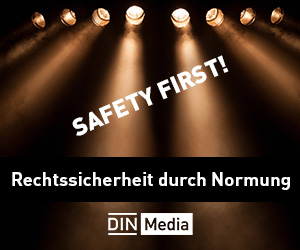



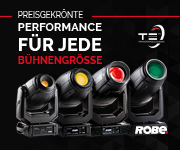

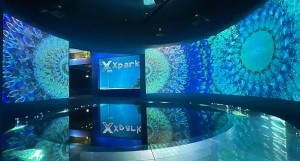
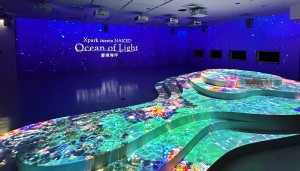
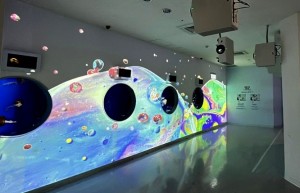
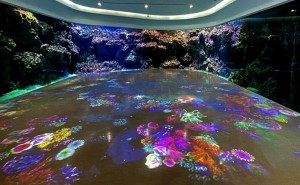
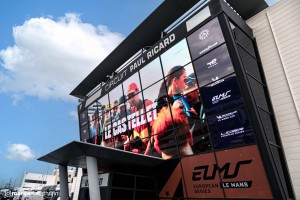
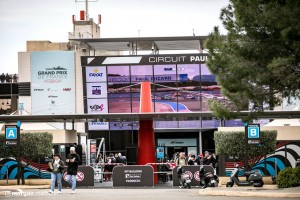
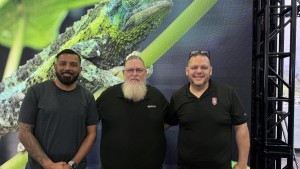
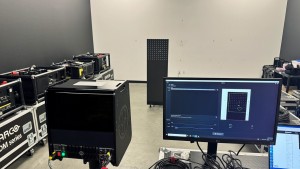
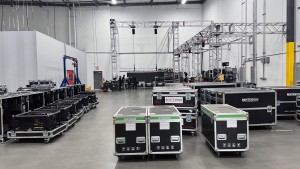
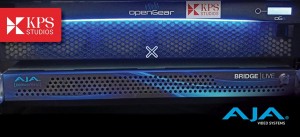
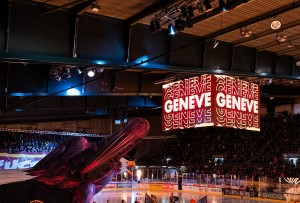
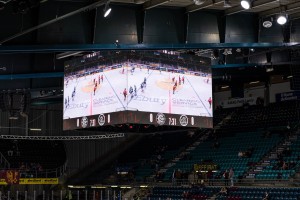
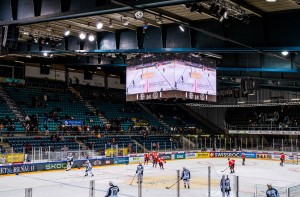
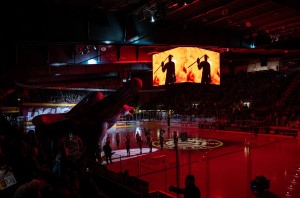
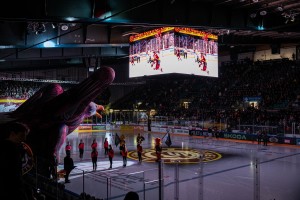
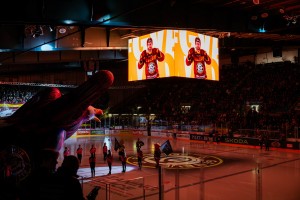
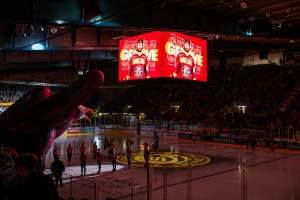
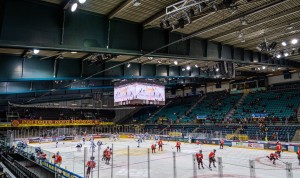
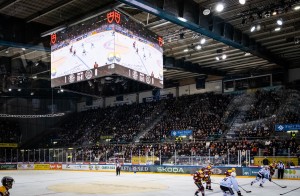
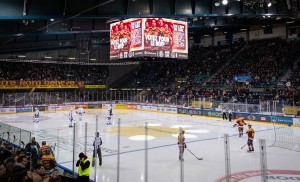
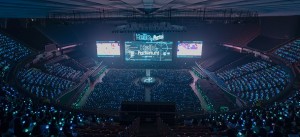
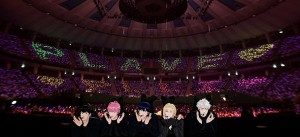
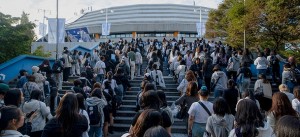
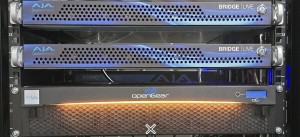
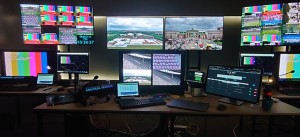
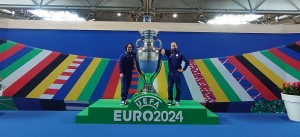
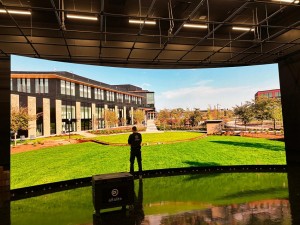
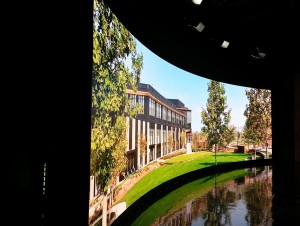
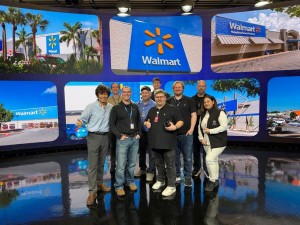
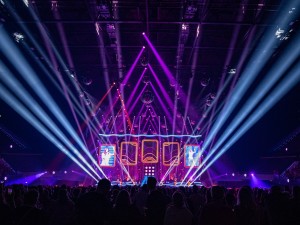
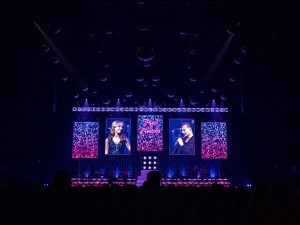
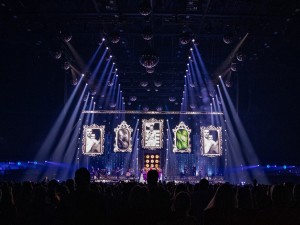
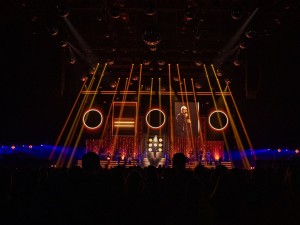
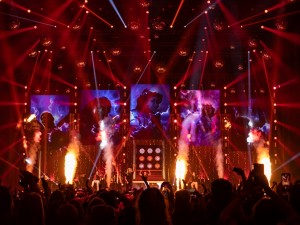
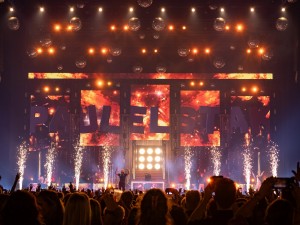
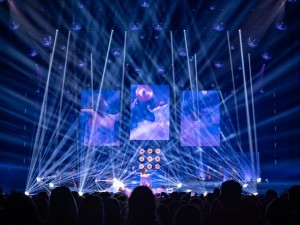
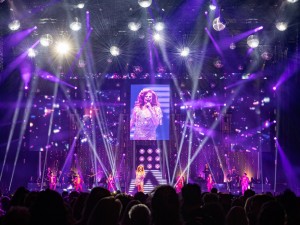
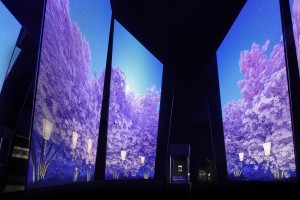
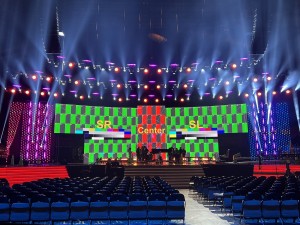
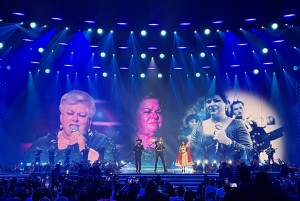
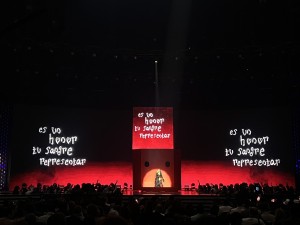
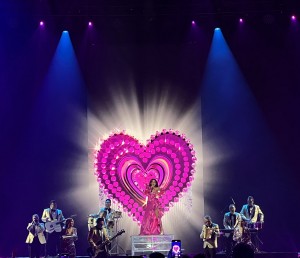
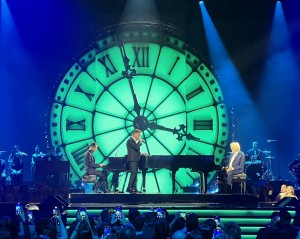
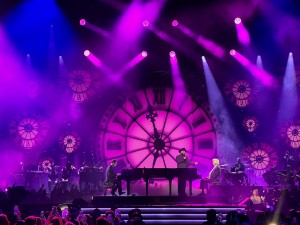
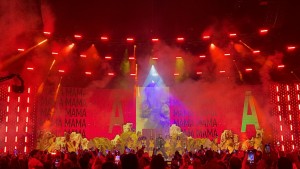
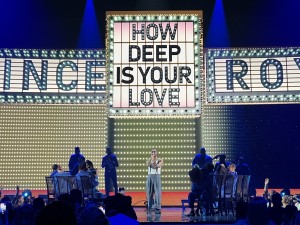
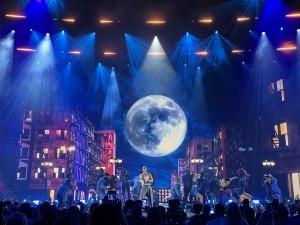
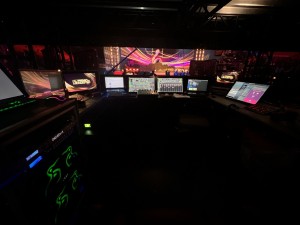
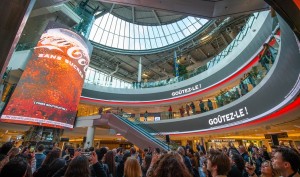
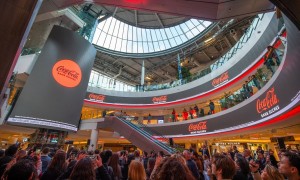
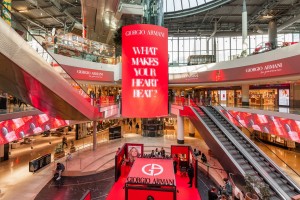
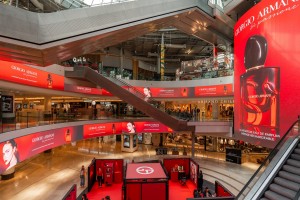
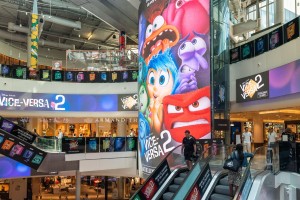
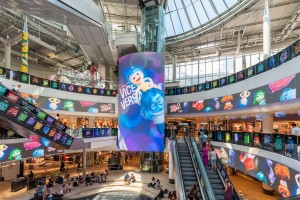

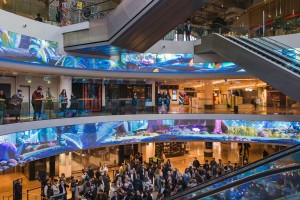
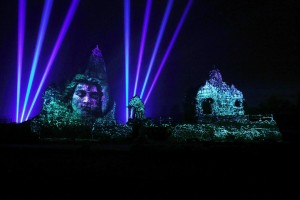
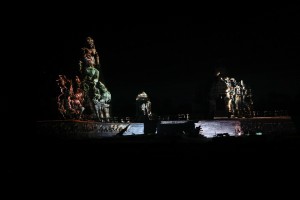
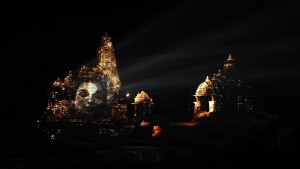
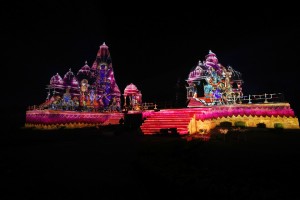
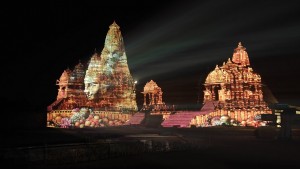
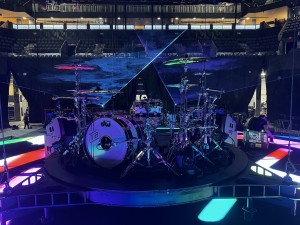
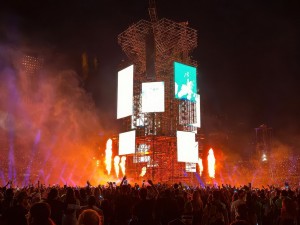

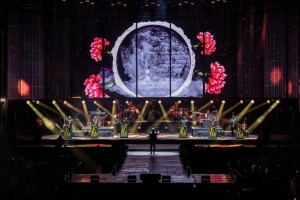
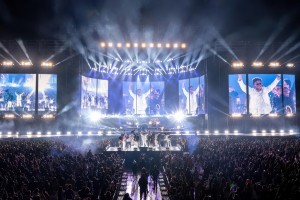
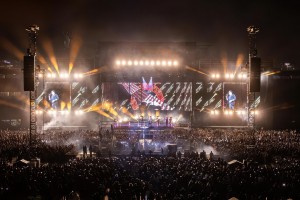
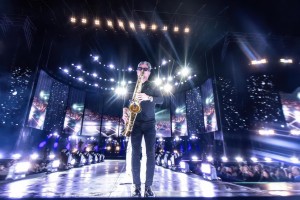
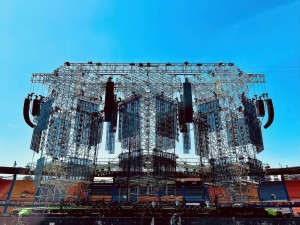
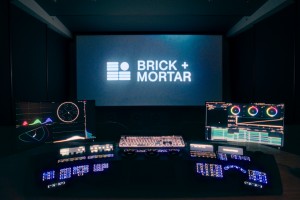
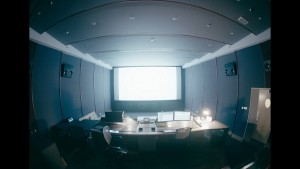
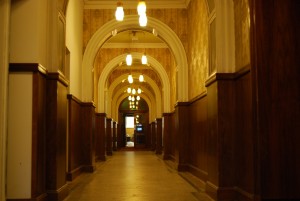
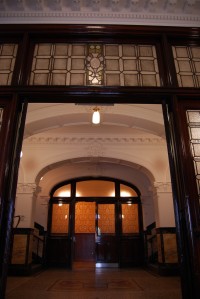
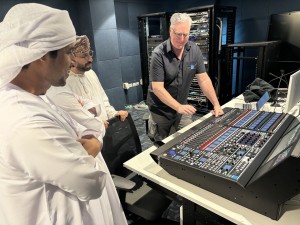
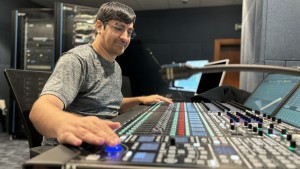
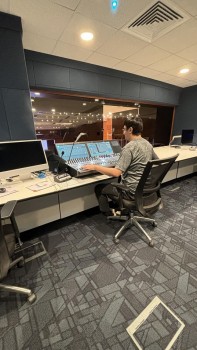
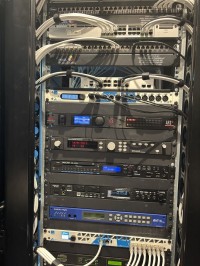
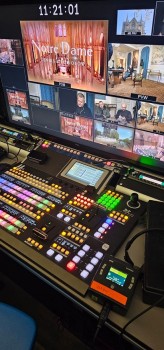
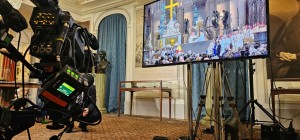
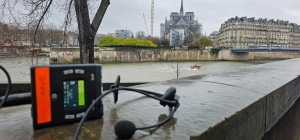
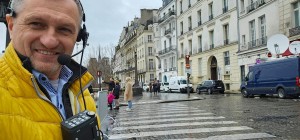
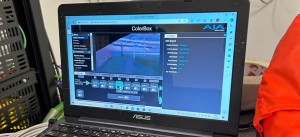
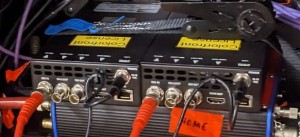
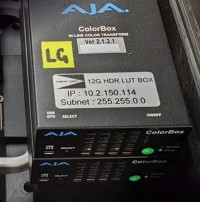
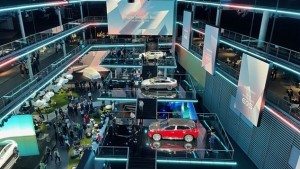
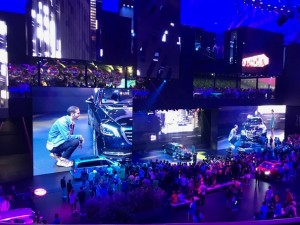
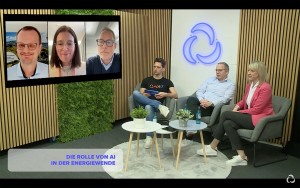
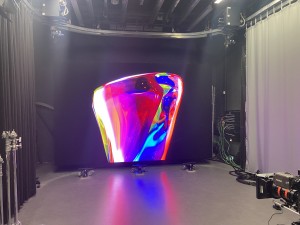
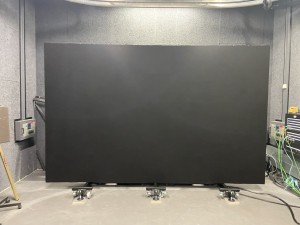
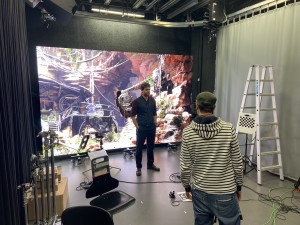
.jpeg)
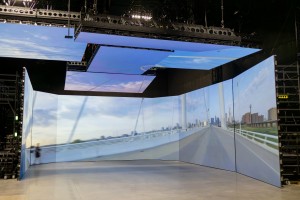
.jpg)
